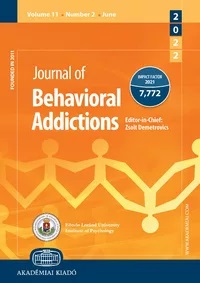Assessing compulsive sexual behavior disorder: The development and international validation of the compulsive sexual behavior disorder-diagnostic inventory (CSBD-DI)
Assessing compulsive sexual behavior disorder: The development and international validation of the compulsive sexual behavior disorder-diagnostic inventory (CSBD-DI)
Author(s): Joshua B. Grubbs, Rory C. Reid, Beáta Böthe, Zsolt Demetrovics, Eli Coleman, Neil Gleason, Michael H. Miner, Johannes Fuss, Verena Klein, Karol Lewczuk, Mateusz GolaSubject(s): Behaviorism
Published by: Akadémiai Kiadó
Keywords: behavioral addiction; hypersexuality; sexual addiction; impulse control disorders; scale development
Summary/Abstract: Background and aims. The World Health Organization's International Classification of Diseases (ICD-11) includes Compulsive Sexual Behavior Disorder (CSBD), a new diagnosis that is both controversial and groundbreaking, as it is the first diagnosis to codify a disorder related to excessive, compulsive, and out-of-control sexual behavior. The inclusion of this novel diagnosis demonstrates a clear need for valid assessments of this disorder that may be quickly administered in both clinical and research settings. Design. The present work details the development of the Compulsive Sexual Behavior Disorder Diagnostic Inventory (CSBD-DI) across seven samples, four languages, and five countries. Setting. In the first study, data were collected in community samples drawn from Malaysia (N = 375), the U.S. (N = 877), Hungary (N = 7,279), and Germany (N = 449). In the second study, data were collected from nationally representative samples in the U.S. (N = 1,601), Poland (N = 1,036), and Hungary (N = 473). Findings. Across both studies and all samples, results revealed strong psychometric qualities for the 7-item CSBD-DI, demonstrating evidence of validity via correlations with key behavioral indicators and longer measures of compulsive sexual behavior. Analyses from nationally representative samples revealed residual metric invariance across languages, scalar invariance across gender, strong evidence of validity, and utility in classifying individuals who self-identified as having problematic and excessive sexual behavior, as evidenced by ROC analyses revealing suitable cutoffs for a screening instrument. Conclusion. Collectively, these findings demonstrate the cross-cultural utility of the CSBD-DI as a novel measure for CSBD and provide a brief, easily administrable instrument for screening for this novel disorder.
Journal: Journal of Behavioral Addictions
- Issue Year: 12/2023
- Issue No: 1
- Page Range: 242-260
- Page Count: 19
- Language: English

